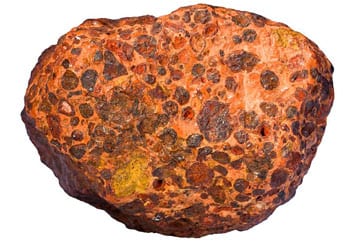Pasirinkite kalbą:
Aliuminis yra labiausiai paplitęs metalo elementas rasti Žemėje, totaling about 8% žemės plutos. Tačiau, aluminum as an element is reactive and therefore does not occur naturally – it needs to be refined to produce aluminum metal. Pagrindinė pradinė aliuminio rafinavimo medžiaga yra boksitas, pagrindinis pasaulyje komercinis aliuminio šaltinis. Bauxite is a sedimentary rock, and consists mostly of the aluminium minerals gibbsite (Al(OH)3), boehmite (γ-AlO(OH)) ir diaspora (α-AlO(OH)), and is usually mixed with the two iron oxides goethite and hematite, the aluminium clay mineral kaolinite and small amounts of anatase (TiO2) and/or ilmenite (FeTiO3).

Boksito indėliai plinta visame pasaulyje, dažniausiai pasitaiko atogrąžų ar subtropikų regionuose. Although proven reserves of bauxite are expected to last for many years, mažėja rezervų, kurie gali būti ekonomiškai pasiekiami, kokybė. Rafinavimo įmonėms, who are in the business of bauxite processing to make alumina, ir galiausiai aliuminio metalas, tai yra iššūkis, turintis tiek finansinį poveikį, tiek poveikį aplinkai.
The process to refine metallurgical bauxite into alumina involves the following inputs:
The following outputs are generated:

The most widely used chemical process of refining bauxite into alumina, the Bayer process, involves dissolving the Al2O3 out of the bauxite rock with caustic soda (Naoh) at elevated temperature and pressure. The Al2O3 fraction of the bauxite is dissolved into solution, to later be precipitated out as alumina. Tačiau, a high-grade bauxite contains up to 60% Al2O3 (Netoli sėjo), and many operating bauxite deposits are well below this, kartais taip mažai, kaip 30-40% Al2O3 (Netoli sėjo). Because the desired product is a high purity Al2O3, likę boksito oksidai (Fe2O3 (Netoli 2004 02, SiO2 (Netoli s, kad, TiO2, Organic material) are separated from the Al2O3 and rejected as alumina refinery resides (ARR) or red mud. Apskritai, žemesnės kokybės boksitas (ie lower Al2O3 content) the more red mud is generated per ton of alumina product. be to, even some Al2O3 bearing minerals, ypač kaolinitas, produce un-desirable side reactions during the refining process and lead to an increase in red mud generation, taip pat brangios kaustinės sodos cheminės medžiagos praradimas, didelės kintamos išlaidos boksito rafinavimo procese.
Raudonasis purvas arba ARR yra didelis ir teirmetis iššūkis aliuminio pramonei. Raudoname purve yra daug liekamosios šarminės cheminės medžiagos, likusios rafinavimo procese, ir yra labai šarminis, dažnai su pH 10 – 13. It is generated in large volumes worldwide – according to the USGS, apskaičiuota pasaulinė aliuminio oksido gamyba buvo 121 milijonai tonų 2016. This likely resulted in more than 150 tonų raudonojo purvo, susidarančio per tą patį laikotarpį. Nepaisant vykdomų mokslinių tyrimų, raudonasis purvas šiuo metu turi mažai komerciškai perspektyvių kelių naudingam pakartotiniam naudojimui. Apskaičiuota, kad labai mažai raudonojo purvo yra naudingai pakartotinai naudojama visame pasaulyje. Instead the red mud is pumped from the alumina refinery into storage impoundments or landfills, kur jis saugomas ir stebimas didelėmis sąnaudomis.
Brangios kaustinės sodos praradimas (Naoh) and the generation of red mud are both related to the quality of the bauxite used in the refining process. Apskritai, the lower the Al2O3 content of the bauxite, kuo didesnis raudonojo purvo kiekis, kuris bus generuojamas, as the non-Al2O3 phases are rejected as red mud. be to, the higher the kaolinite or reactive silica content of the bauxite, daugiau raudonojo purvo bus sukurta. The reactive silica content not only increases the volume of red mud, but also consumes caustic soda reagent and reduces the yield of Al2O3 recovered from the bauxite. Todėl, there is both an economic and environmental argument to be made for improving the quality of bauxite prior to refining.
STET sauso atskyrimo procesas suteikia boksito gamintojams arba boksito rafinavimo įmonėms galimybę atlikti boksito rūdos modernizavimą prieš Bayer procesą, siekiant pagerinti kokybę. Šis metodas turi daug privalumų:
Apibendrinant, sausas apdorojimas STET separatoriumi suteikia galimybių boksito gamintojams ir naftos perdirbimo įmonėms sukurti vertę. Išankstinis boksito perdirbimas prieš rafinavimą sumažins chemines išlaidas, sumažinkite susidarančių raudonojo purvo tūrį ir sumažinkite proceso sutrikimus.
Nuorodos: